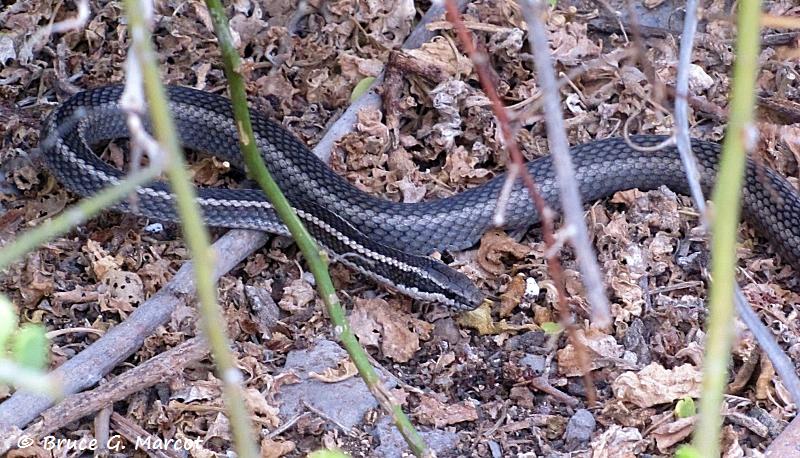
|
|
Hood Racer: An Allopatric Sibling |
|
|
Click on images for larger versions
|
Hood Racer (= Española
Snake) (Philodryas biserialis hoodensis), Family Colubridae |
Credit & Copyright:
Dr. Bruce G. Marcot
|
Explanation: This beautiful, unassuming serpent has much to teach about taxonomy and evolution. This is the only snake resident on the tiny island of Española (also called Hood Island), in the remarkable archipelago of the Galapagos Islands, made famous by the explorations of Charles Darwin. The Galapagos are known for their "Darwin's finches," that set of 13 species known, from Charles Darwin's research, for having evolved a diversity of bill shapes, body sizes, and nesting behaviors, from an original immigrant species. However,
less commonly known is the diversity of other life forms that have also
evolved on those islands ... including this fine serpent. So if you see a snake on Hood (Española) Island, just by distribution alone you can be sure it's a Hood Racer. Usually. However, it's important, as a naturalist, not to always jump to conclusions about species identification based just on distribution alone. I say this because the three species of snakes on these islands are very difficult to tell apart, being best distinguished by scale counts, that is, the number of scales on various parts of the body (much like various species of garter snakes in western North America) ... ... such as: the size, shape and number of scales between the nasal openings on the head, the number of scales along the upper and lower "lips," the number of body scales counted around the neck, mid-body, and tail, and the number of scales covering the anal opening. You
pretty much have to have the snake in hand to determine all this! This snake has been identified as belonging to genus Philodryas. And also Pseudalsophis. In Philodryas, it is named as subspecies Philodryas biserialis hoodensis. But in Pseudalsophis it is named as a full, separate species, Pseudalsophis hoodensis. Some sources even use Philodryas hoodensis as the full species. Confused yet? What is interesting is that Hood Racer (by any other name) had somehow made it to its current location of its three islands -- and then diverged in morphology (body form, including the scale counts mentioned above) into the species (subspecies?) we know today. Its two very similar "sibling species" cousins, on the other islands, also diverged, in isolation ("allopatry," as ecologists call it). And chances are strong that these snakes continue to change from each other over time.
So
here is a fine example of a complex taxonomic (scientific naming) knot ...
resulting from allopatric (separated) sibling (similar) species ... as yet
another great instance of Darwin's evolutionary theory come to life, on these
amazing islands that continue to provide surprises.
|
Next week's picture:
Brown Noise in Flight
< Previous ... | Archive |
Index |
Location | Search | About EPOW | ... Next >
|
|
Author & Webmaster: Dr.
Bruce G. Marcot
Disclaimers and Legal
Statements
Original material on Ecology Picture of the Week ©
Bruce G. Marcot
Member Theme of The Plexus